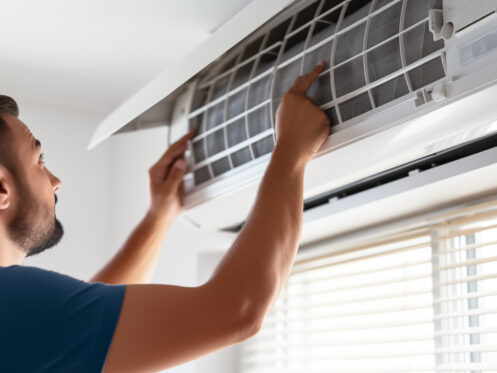Ductless mini-splits offer several compelling advantages for homeowners looking to improve comfort, reduce energy costs, or upgrade an older HVAC system. These systems go beyond simply providing heating and cooling. They give you more control over your indoor environment while avoiding some of the issues that come with traditional ducted systems. Whether you’re remodeling, adding on to your home, or just exploring more efficient options, a ductless mini-split may be worth considering.
How Ductless Mini-splits Work
Ductless mini-splits operate by transferring heat rather than creating it. The system consists of two main components: an outdoor condenser unit and an indoor air-handling unit in each space you want to heat and cool. These two parts are connected by a narrow conduit that contains refrigerant lines, a power cable, and a condensate drain. Unlike traditional HVAC systems that rely on a network of ducts to move air, mini-splits deliver conditioned air directly to specific areas of the home.
The refrigerant plays a key role in how the system functions. During cooling mode, it absorbs heat from inside the home and carries it to the outdoor unit, where it is released into the air. In heating mode, the process is reversed. The refrigerant extracts heat from the outdoor air (even when it’s cold outside) and brings it indoors. This heat transfer method is part of what makes mini-splits highly efficient.
Each indoor unit is mounted in the room it serves and includes its own evaporator coil and blower fan. These units can be wall-mounted, ceiling-mounted, or recessed, depending on the layout and aesthetics of the space. Because the system uses refrigerant lines instead of ducts, installation is typically less invasive and more flexible. A small hole in an exterior wall, usually about three inches in diameter, is all that is needed to run the conduit between the indoor and outdoor units.
Benefits of Choosing a Ductless Mini-split
Mini-splits are becoming a more popular choice for homeowners in Richmond, KY. This is because they offer several advantages compared to traditional systems, including greater temperature control, lower energy costs, and fewer maintenance expenses.
Room-by-Room Temperature Control
One of the standout advantages of ductless mini-splits is the ability to control temperatures independently in different parts of the home. Each indoor unit operates on its own thermostat, allowing household members to set the temperature in their own rooms for personalized comfort. This zoning capability not only adds convenience but also
means you can adjust the thermostat for more economical heating or cooling in spaces that are not used all the time. For example, a guest room that is rarely occupied doesn’t have to be cooled or heated when not in use, helping to save energy and reduce costs.
Improved Energy Efficiency
Mini-splits avoid the energy losses typically associated with ductwork. According to the U.S. Department of Energy, homeowners can lose up to 30% of their conditioned air through faults in ductwork, especially when it runs through attics and crawl spaces. By delivering conditioned air directly into each room, mini-splits eliminate these losses and reduce your overall energy use.
Year-Round Comfort
Ductless systems include heat pump technology, allowing them to provide heating and cooling. This capability means that you do not have to invest in and maintain separate heating and cooling systems.
Quieter Operation
Ductless mini-splits are known for their remarkably low sound levels, with many units operating at noise levels comparable to a quiet conversation or the hum of a refrigerator. This is due to their design, which eliminates the need for noisy air ducts and the high-powered blower fans found in traditional central HVAC systems. Because the indoor units are smaller and have less moving air, they run more quietly, making them an excellent choice for bedrooms, nurseries, offices, or other spaces where noise is a concern. The result is a more peaceful indoor environment without sacrificing comfort.
Flexible Installation Options
Because they don’t rely on ducts, an HVAC technician can install mini-splits in homes without existing ductwork. They are also a fantastic option to heat and cool remodeled basements, garages, and attics where extending ductwork would be impractical or cost-prohibitive. Wall-mounted units are the most common, but ceiling cassettes and floor-mounted models are also available, giving homeowners flexibility.
Lower Maintenance Needs
Without ducts to clean or maintain, ductless systems require less upkeep than traditional HVAC systems. Homeowners typically just need to clean the filters once a month and schedule bi-annual professional maintenance to keep the system in good condition. Many systems also include indicators that remind you when it’s time for filter cleaning.
Air Filtration and Indoor Air Quality
Mini-splits come equipped with advanced filtration systems designed to capture dust, allergens, and other airborne particles. This added filtration can make a noticeable difference for people with allergies or asthma and may reduce reliance on portable air purifiers.
Potential Incentives and Rebates
Because of their energy-saving potential, ductless mini-splits may qualify for rebates or tax incentives through local utility companies or federal programs. Homeowners interested in upgrading their system should check what incentives might be available in their area.
Potential Downsides to Consider
Mini-splits can be a great option for homeowners, but they’re not perfect for every home. There are some important downsides to consider.
Higher Upfront Costs
Mini-splits tend to come with a higher upfront cost compared to traditional HVAC systems, especially when factoring in both the equipment and professional installation. Unlike more budget-friendly options like window units for cooling, mini-splits require precise installation. This means that while mini-splits can save energy in the long run, they involve a larger initial investment.
Visible Indoor Units
One consideration homeowners need to keep in mind is the aesthetic impact. Unlike traditional ducted systems, with a mini-split system, you will have indoor air handlers in each room. While these units are often sleek in design, they are still visible in your living space. This can be a major consideration for homeowners who prefer a minimalist look.
Cost of Covering Larger Homes
For larger homes, the cost of installing multiple indoor units can add up quickly. A single outdoor compressor can typically support up to five indoor units, depending on the system model and size. However, when you exceed the recommended number of indoor units per outdoor unit, additional outdoor compressors may be necessary. This substantially adds to the system’s purchase price. Understanding how many units you need and how many outdoor compressors are required can help you decide whether a ductless mini-split system fits your budget.
Contact Your Local Professionals
At Affordable Service Solutions Heating & Air Conditioning, we are a family-owned AC company that has been serving the residents of Richmond, KY and the surrounding areas since 2012. We install, maintain, and repair heating and cooling systems, including mini-splits. Contact us today to schedule an appointment with one of our experienced technicians to help you decide if a mini-split system is the right choice for your home. Be sure to ask us about our maintenance agreement!

